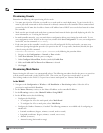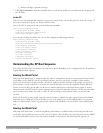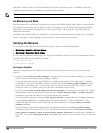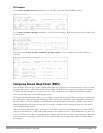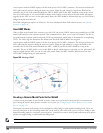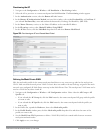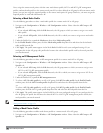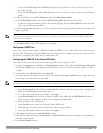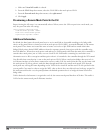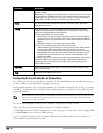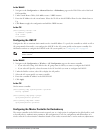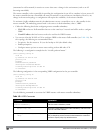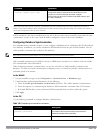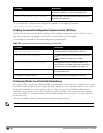
476 | SecureEnterpriseMesh DellPowerConnectW-SeriesArubaOS6.2 | User Guide
a. Make sure Virtual AP enable is selected.
b. From the VLAN drop-down menu, select the VLAN ID for the mesh private VLAN.
c. From the Forward mode drop-down menu, select split-tunnel.
d. Click Apply.
Provisioning a Remote Mesh Portal In the CLI
Reprovisioning the AP causes it to automatically reboot. When you use the CLI to reprovision a mesh node, you
may also provision other AP settings.
(host)(config) #provision-ap
read-bootinfo ap-name <name>
mesh-role remote-mesh-portal
reprovision ap-name <name>
Additional Information
By default, the data frames the mesh portal receives on its mesh link are forwarded according to the bridge table
entries on the portal. However, frames received on mesh private VLAN (MPV) are treated differently by the remote
mesh portal. These frames are treated the same as frames received on a split SSID and are routed rather than
bridged. Mesh points obtain DHCP addresses from the corporate network. then register with the controller using
these IP addresses. When these mesh points send and receive PAPI control traffic from the main office controller, it
controls these mesh points just as if they were on a local VLAN. PAPI traffic containing keys and other secret
information receives IPsec encryption and decryption when it is forwarded to the controller through the VPN tunnel.
Not all traffic from a mesh point is sent on the mesh private VLAN. When a mesh point bridges data received via
its Ethernet interface or from clients connected to an access radio VAP, the mesh point does not tag the frame with
the mesh private VLAN tag when it sends the data through mesh link to the remote mesh portal. Note that the
mesh point may still tag the frame depending on the VLAN of the virtual AP and the native VLAN specified in the
system profile. Care must be taken to assign the MPV value so that it does not clash with any local tags assigned in
the mesh network. In this case, the portal performs the default operation that is to bridge the frame based on its
bridge table.
Traffic destined to the Internet is recognized as such by the remote mesh portal based on ACL rules. This traffic is
NATed on the remote mesh portal’s Ethernet interface.



